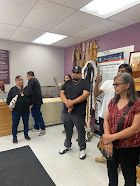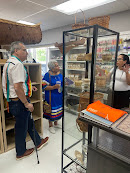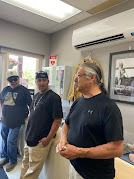A group of people traveled to Ontario from Manitoba to visit the Chalk River Nuclear site. The reason they went was to try get and understanding of what it means to decommission a Nuclear site. The visit was very interesting, scary and fun. The interesting part was the visual anticipation of what a Nuclear site looked like. The scary part is we are talking radiation here. The fun part was the Sagkeeng Leadership and the Elders along for the trip. The Sagkeeng group were fully engaged in listening to the various parties that were met.

We'll discuss the visit reasons a bit more later in the post. The good news was visiting, meeting a First Nation we had not known before our trip to their Territory. Pikwakanagan was our last visit to the region. Our Chief, EJ Fontaine, Councilors, Tanya Bunn, Dwight Swampy, Johnnish Courchene, Henry Swampy lead the delegation of Sagkeeng Members. The delegation comprised of Elders, and youth representatives of our Band. At Pikwakanagan we were hosted to a tour of their community, a history of their Nation, and a Ceremonial Feast. Our hosts were Chief Greg Sarazin, Council Don Bilodeau, Merv Sarazin, PJ Leroux, Vicky Two Axe, Sherry Kohoko, Dale Benoit and community Elders and members.

There were welcoming remarks, gifts given to our delegation from Chief and Council. Our Chief of Sagkeeng and Elder Mary Starr presented gifts to the Chief and Council. Both Chiefs were gracious in their remarks and hoped to establish a friendship and information network. It never ceases to bring me pride at how generous, kind and full of joy our people are. Doesn't matter the community, when strangers come in, they are treated better than cousins and family (family can be annoying that's why). Pikwakanagan is very proud (and rightly so) of their community. They have a rich history and are known for the Birch Bark Canoes. A legacy of Traditional Canoe building which still carries on in the community. The people of Pikwakanagan are fully engaged in Traditional practices. The language, like all our communities, has been attacked and is full of scars. Thanks to their community, a revitalization of the Language is part of their focus.

Piwakanagan has been active in voicing their concerns regarding Chalk River for a long time. It seems they are finally having discussions with Chalk River. The Chalk River does pose real threats to their territory. Chalk River is the dumping ground for Nuclear waste from plants all over Canada. As history reveals, no consideration of the Indigenous population has been the reality of decisions made by Canada to Pikwakanagan members ( and other First Nations in all sectors). The 1952 and 1958 nuclear "accidents" at Chalk River are examples of how serious the threat is to the Land, the Water, the Wild life and people. Our group visited the Pikwakanagan people and how they are affected. How they are now moving forward with the radiation threat in their yards. The reason we are interested is due to the Pinawa Nuclear plant decommission in Manitoba. In 1978 WR-1 nuclear plant leaked 2,731 radioactive oil into the Winnipeg river, the drinking source of Sagkeeng. It took "several weeks" to find and repair the leak. Guess who didn't know about the leak? The Indians of course (but why do they matter anyways). The situation of Pinawa is of great concern to the people in the area, as it should be. So, the reason for the trip to Chalk River and Piwakanagan. Pinawa has plans in place to continue dismantling the site. The company dismantling the Pinawas site, didn't even consider Sagkeeng in the conversation. The Canadian Nuclear Laboratories (CNL) failed to speak with Sagkeeng, In 2018 Sagkeeng Leadership said "Hey man, you fuckers didn't even consult us" or words to that affect. Now there is a delay of the decommissioning process. There are safety concerns to the area, the Land, the Water, Water the people drink.

When Sagkeeng met with CNL representatives there were lots of laughs. Our community, as a whole, are known for their teasing, their joking and their laughter. They are also know for being Zanagizi (can be difficult). We were being provided with a presentation at the Chalk River site by their representatives, I felt for a second that I was in a Band meeting (Band meetings in our Reserve anyway, can be volatile). There were some hard, some very harsh words being delivered by a few people in our delegation. One of our Elders is quite known for Ombiigizi at meetings. One thing for sure, she is known for her aggression at meetings. Thing about Sagkeeng is their quick turns. One minute they are hammering you and the next they are laughing, teasing and joking with you. I always wonder if White folk think "these Indians are crazy," one moment drilling you and the next second, it's like you are "their best friend." For me I have seen this before at meetings, shooting arrows at the Wagons and the next thing fixing their wheels. I know it is a release of the way things have always been for Neechies, (an ugly system that ignores First Nations) the Whites have no real consideration for us. So these Chalk River representatives are just Poogets. They are not the decision makers, they are just there to fluff our pillows, pacify the Indians. The real decisions makers are sitting in the Big Office. Our people know this too, but, Hey if we get a chance to voice, we will voice. Even if we know it is voicing to the bottom-barrel people.
Speaking about our loud one, it was embarrassing for us, when she spoke at the Community Feast (man the food was good, Moose meat on the menu) and lectured Piwakanagan. The issue of the nuclear situation is scary. This Elder spoke on how she is afraid for the children, grandchildren to be brought into the world where radiation from the Pinawa plant is a possibility. Our Elder is known to be vocal, but a well meaning person. The problem for me is this: you don't go into someone's home and lecture them or scold them. The Piwakanagan Nation is not responsible for the radiation in our area. They are working to ensure that their people, their community, their water, the Land is safe for their generations as well. The Sagkeeng Elder was wrong. Sure, the Elder can say they are passionate and make no apology for it, but it was still very wrong. Piwakanagan was hosting us in their home, feeding us, gifting us and we have the nerve, the audacity to scold them. It was embarrassing. I felt for our Chief and Council, and our community that we could insult our hosts. A strong Piwakanagan Ikwe stood and answered our Mongidone. For Piwakanagan the issue is safe storage, and a voice in what takes place. The past is done, the Nuclear plants have been built and placed with no Indigenous consideration at all. The damage is done, now how can we make sure our children are safe and what can we do in this case. The issue is now the aftermath of the nuclear plants. Chalk River is Algonquin territory and should be involved. The problem for the Algonquin Nation is the site is a dumping ground for radioactive material. The radioactive rods from Pinawa plant are being stored at chalk river. What we have to consider is the building. In Pinawa the building is 90 feet under ground. Most of the radioactive material is gone, maybe there is still some of the lesser things, like the radiation suits, gloves and things like that. I am not sure but I think it has already been moved to Chalk River. Chalk River has a lot of Sea-Cans (those big steel containers used to ship stuff on those big Ships) which are full of the "low radiation" materials, like worker contamination gear. Chalk River is also a storage site for High Level Radioactive materials.

Sagkeeng has work to do: learn all they can about the Pinawa proposals for nuclear waste clean-up, storage. I grew up in Sagkeeng and lived through the Pinawa Radiation spill era in 1978. We were swimming all the time, fishing. My Dad, along with many others in the Reserve, netted fish in the Winnipeg river and we angled fish. Winnipeg River is our source of drinking water. The thing is we never knew about the spillage. In comparison, we were made aware of the dumping sewage from the Paper mill into the River, but it was reported to the Band long after the spill had taken place. The Mill was the main polluter, in our area, at least we thought (third worst polluter in Manitoba). The Paper Mill was notorious for polluting the river and the air, not including the decimation of the Forest. There was no incentive or instruction in the Law to inform the Indians of any "incidents," like spillage into the waterways. Little did we know of the nuclear spills from Pinawa nuclear plant. We had no knowledge of the oil dumped into the River system. We were kind of aware of the Nuclear plant in Pinawa but didn't really comprehend the magnitude of what it meant. Now the actions of the various companies have not been historically transparent. The result, a reluctance from Indigenous communities to say "sure, we trust you, go ahead and do you." How can we can trust someone who has a history of not being honest?
So now the situation is this: remove the physical plant from the under ground, then store the plant into shipping containers, move those containers across 2,000 kilometers and then store it at the Chalk River site. Okay that's cool. Or we can do this, Leave the high level radioactive building in the ground, but cover it with concrete material. Contain the radiation and just watch it (monitoring) the next hundred years or so. The preferred method of storing High Level Waste (HWL) is for deep cavern burial. At Chalk River they have above ground storage vessels (Near Surface Disposal Facility NSDF).
 So, what's our play here? Risk exposure of the radiation to the area by digging it out of ground, dismantling it, put in containers big enough to hold the dismantled building, ship the tons of material across different people's territories and store it at some other First Nation's territory. Like NIMBY, out of my sight, so it's not my problem.
So, what's our play here? Risk exposure of the radiation to the area by digging it out of ground, dismantling it, put in containers big enough to hold the dismantled building, ship the tons of material across different people's territories and store it at some other First Nation's territory. Like NIMBY, out of my sight, so it's not my problem.
A difficult decision but really no choice in the matter. Sagkeeng cannot willingly want to put radioactive material in the yard of another Indian. Yet we shouldn't have the radioactive material in our own yard as well. So do we condemn relatives to the radiation? Or do we keep it locked in the ground and hope for the best? As it is, we have little choice to go with the best techniques at hand.
We need to keep it locked in the ground. The best or least worse option is to keep it buried. In the future the science may get better.
Sagkeeng could have their own people trained for monitoring the site (at least 50 years). Of course there will be risks. Sagkeeng had a person whose job was to work with the Pinawa plant's activities (the decommission). The problem with this was, although the guy is a relatively nice, friendly, affable, he didn't do anything as far as we could tell. No information was provided to the community. Going forward we will need people to be good, competent at the job. They will be the alarms for the community. Your alarm is only as good as the person is at their job. Remember Walkerton Ontario, when the water monitor ending up killing 7 people, making 2000 people sick. Some of those people still have long lasting issues now. There was monitoring in place but it failed due to human error. Other risks include the Private sector influence on the nuclear sector. Canada's Conservative government gave (sold) the Nuclear sites to CNL. We know in other resource sectors, the private companies abandon the work sites once they exhaust the resources. The clean-up is not always complete, will this happen with nuclear sites?
The Nuclear industry is a mine field of danger, environmental risks, moral dilemmas, and of course greed. Canada is rich in Uranium and is the largest supplier of medical isotopes. The Nuclear industry will only expand as the private sector likes money.
Sagkeeng will need to be involved in the actions of Pinawa shut down. Decision should be to keep it buried, and watch it closely for the future. It is the best practice of the day. Most likely the cheapest cost for CNL as well.






 So, what's our play here? Risk exposure of the radiation to the area by digging it out of ground, dismantling it, put in containers big enough to hold the dismantled building, ship the tons of material across different people's territories and store it at some other First Nation's territory. Like
So, what's our play here? Risk exposure of the radiation to the area by digging it out of ground, dismantling it, put in containers big enough to hold the dismantled building, ship the tons of material across different people's territories and store it at some other First Nation's territory. Like 







